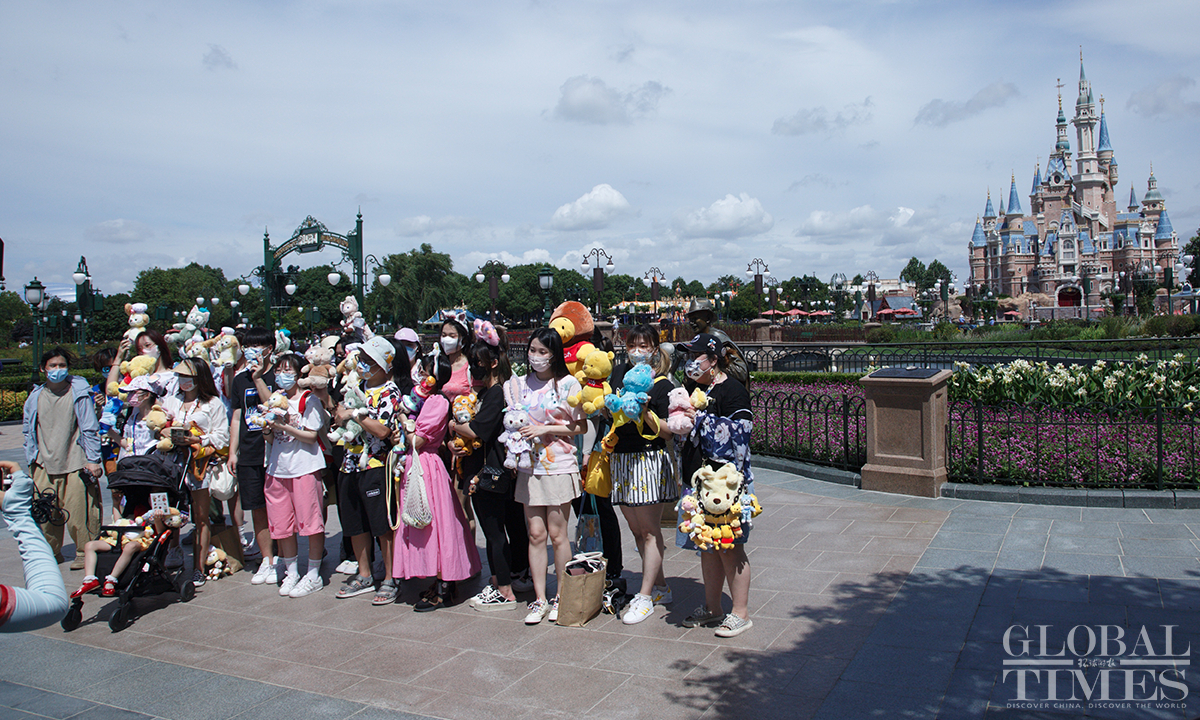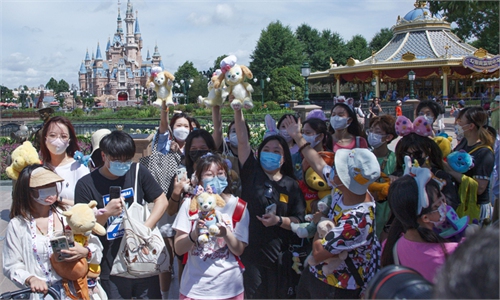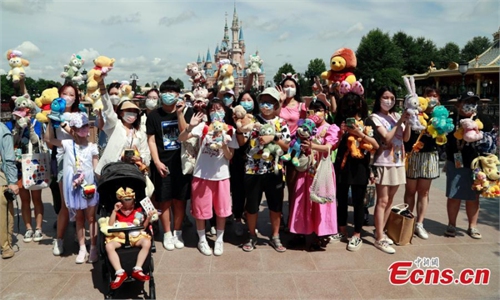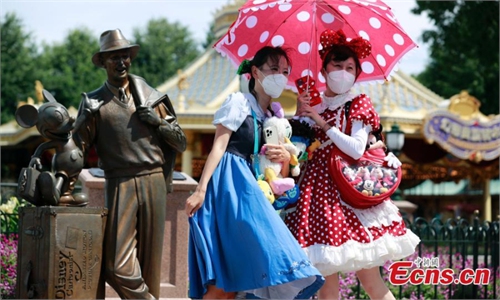Tourism booms after relaxed COVID rules; China's strong economic resilience to reward precise epidemic prevention approach

Photo: Wu Shiliu
Against the backdrop of bright sunshine, floating music, passionate cast members and smiling tourists, Shanghai Disneyland reopened on Thursday morning after a more than three-month lockdown.
The big welcome at Shanghai Disneyland came after China on Wednesday announced the nationwide travel tracking system will no longer mark cities having areas of COVID-19 infection risks. Market watchers said the confidence for an economic rebound when COVID-19 is not yet over is because China has built up an effective system of normalized epidemic prevention and control, and strong economic resilience will further reward the persistence of a precise epidemic approach.
A 19-year-old girl surnamed Yuan, who arrived at the theme park with her friend immediately after its reopening, told Global Times reporters on Thursday that she was "so excited" that she only slept for about three hours last night.
The reopening of Shanghai Disneyland plays an "amplifier" role in the post-epidemic recovery of the cultural tourism industry in Shanghai and the whole country, Huang Xiaojie, Chief Marketing Officer of qunar.com told the Global Times on Thursday.
In fact, before the reopening of Shanghai Disneyland, the country's summer travel market is welcoming a turning point as more cities loosened COVID-19 test policies by either reducing the frequency of tests or suspending regular weekly testing.
To encourage summer travel, nearly 500 scenic spots across China have announced free tickets or discounts for special groups, such as students and medical workers, according to Trip.com, and more sites are expected to join in.
Several airlines such as Hainan Airlines have rostered larger aircraft from single-aisle to wide-body aircraft such as the A330, which can carry around 400 passengers on flights from Shanghai to Sanya, South China's Hainan Province.
Hotel booking numbers also look promising, as the number of hotel reservations nationwide via qunar.com in the past week has exceeded the same period in 2019.
The rebound in tourism will greatly boost the recovery in transportation, especially passenger transportation that has been hit hard, and it will boost regional development, especially in rural and remote regions, Mei Xinyu, a research fellow with the Chinese Academy of International Trade and Economic Cooperation under the Ministry of Commerce, told the Global Times on Thursday.
Many localities are already staging a steady recovery in June in their consumption and for the whole nation, social retail growth will definitely return to positive territory by September. It is only a matter of how much that growth will be, Cao Heping, an economist from Peking University, told the Global Times.
Precise epidemic approach
China on Wednesday said that it will no longer mark cities with COVID infections in the travel tracking system to balance epidemic control and socioeconomic development, which will stimulate the travel market.
In practice, those from marked cities usually face restrictions that prevent them from traveling unless they undergo quarantine at their destination.
The search volume of air tickets on the platform increased by 60 percent within 30 minutes of the news, the search volume of hotels doubled, and the search volume for train tickets increased by up to 1.5 times, according to online travel platform qunar.com.
A senior expert from the Chinese Center for Disease Control and Prevention (CDC) told the Global Times that China's system of normalized epidemic prevention and control is why there is so much confidence in the resumption of travel.
The dynamic zero-COVID policy has been optimized over time, as China has always been exploring an epidemic control approach that suits the time and needs, and now it is more scientific and precise. Newly infected travelers could be tracked and quarantined in time to prevent a large-scale outbreak and the circuit-breaker mechanism for cross-provincial trips will stabilize the tourism market, the CDC expert noted.
Under the mechanism, a county-level region has to prevent travel groups from entering or leaving if an outbreak has occurred in the previous 14 days or cumulative local cases have exceeded 50, according to China's national authority for culture and tourism.
Wednesday's removal of the asterisk from the travel tracking system is a concrete manifestation to implement the CPC Central Committee's requirement that "the epidemic must be contained, the economy must be stable and development must be safe," Wu Zunyou, China's CDC chief epidemiologist, posted on his personal Weibo on Thursday.
Wu said that it will help better coordinate epidemic prevention and control with economic and social development as it encourages people in areas of low infection to travel and it offers no excuse for some local governments to continue placing extra resections on people who should not have been restricted.
Chinese President Xi Jinping stressed during his inspection in Wuhan, Central China's Hubei Province on Wednesday, that while the city was hit hard by COVID-19 two years ago, that China has the capability and strength to implement the dynamic zero-COVID policy until the final victory is secured.
"Even if there are some temporary impacts on the economy, we will not put people's lives and health in harm's way, and we must protect the elderly and the children in particular," Xi said. "If we make an overall evaluation, our COVID-19 response measures are the most economical and effective."
Chinese experts said that three factors underline the resilience of the Chinese economy - the long-term expectation for an increasing income, China's comprehensive industrial layout that ensures any new growth points will not be missed out by the country, and adaptive, effective policy support - still remain unchanged, although China has suffered a decline in retail due to the flare-up of COVID-19 in major cities such as Shanghai and Beijing.
A tangible rebound in the six industries that had their fortunes based in the gathering and flowing of people, such as dine-in service at restaurants, bodes well for the prospect of Chinese economic growth in the second half. The kind of recovery we are seeing at restaurants and tourist spots bear the mark of a V-shaped recovery, and there is reason to believe it can be sustained in the coming months, Cao said.
"By preserving such expectations, strengthening industrial power, and implementing sound policy, more precise epidemic control will be handsomely rewarded," Cao noted.



